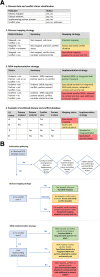Complex emergencies and the control and elimination of neglected tropical diseases in Africa: developing a practical approach for implementing safe and effective mapping and intervention strategies
- PMID: 33789715
- PMCID: PMC8010498
- DOI: 10.1186/s13031-021-00356-7
Complex emergencies and the control and elimination of neglected tropical diseases in Africa: developing a practical approach for implementing safe and effective mapping and intervention strategies
Abstract
Background: Complex emergencies resulting from conflict and political instability are a major challenge for national neglected tropical diseases (NTDs) control and elimination programmes, especially in sub-Saharan Africa. Currently, there are no formal guidelines for national programmes to use and plan activities in these humanitarian situations, therefore the aim of this study was to develop a new methodological approach for making decisions about the implementation of safe and effective mapping and mass drug administration (MDA) intervention strategies.
Methods: The study focussed on the 47 World Health Organization's African Region (AFR) countries. NTD data were based on five diseases controlled by preventive chemotherapy (PC; i.e. lymphatic filariasis, onchocerciasis, schistosomiasis, soil transmitted helminths, trachoma), obtained from the WHO data portals and The Global Trachoma Atlas for 2018. Data on complex emergencies were obtained from the Armed Conflict Location and Event Data Project for 2018-2019. NTD and conflict data were summarised and mapped. A decision tree was developed using NTD mapping, endemicity, MDA and implementing partners data, together with conflict status information at district level. South Sudan was used as a case study, given its current nexus of high NTD prevalence, incidences of conflict, and the presence of a national NTD programme and supporting partners.
Results: For the five NTDs, between 26 and 41 countries required PC, 69.2-212.7 million people were treated with coverage between 54.8-71.4%. In total 15,273 conflict events were reported including high rates of violence against civilians (29.4%), protests (28.8%), and battles (18.1%). The decision tree process included four main steps including i) information gathering ii) determine a disease mapping strategy iii) determine an MDA implementation strategy and iv) create a disease and conflict database. Based on these steps, risk maps were created. The South Sudan case study on onchocerciasis found the majority of the districts requiring mapping or MDA had a conflict event, and required specialised methods adapted to context and risk, with support from implementation partners in selected areas.
Conclusions: The paper presents a new methodological approach for implementing safe and effective mapping and intervention strategies in NTD endemic countries with ongoing complex emergencies, which will help to address challenges and make progress toward the NTD Roadmap targets of 2030.
Keywords: Complex emergencies; Conflict; Crisis; Lymphatic filariasis; MDA; Mapping; Mass drug administration; NTDs; Neglected tropical diseases; Onchocerciasis; SDGs; Schistosomiasis; Soil transmitted helminths; South Sudan; Sub-Saharan Africa; Sustainable development goals; Trachoma.
Conflict of interest statement
The authors declare that they have no competing interests.
Figures





References
-
- Burkle FM, Kushner AL, Giannou C, Paterson MA, Wren SM, Burnham G. Health care providers in war and armed conflict: operational and educational challenges in international humanitarian law and the Geneva conventions, part I. historical perspective. Disaster Med Public Health Prep. 2019;13(2):109–115. doi: 10.1017/dmp.2018.41. - DOI - PubMed
-
- World Health Organization. Environmental health in emergencies. Complex emergencies [Internet]. Key policy documents. 2019. Available from: https://www.who.int/environmental_health_emergencies/complex_emergencies...
LinkOut - more resources
Full Text Sources
Other Literature Sources

